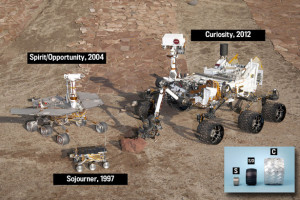Mars regained the world’s attention this fall, with recent news of the discovery of liquid water on the planet and a new blockbuster film set on Earth’s nearest neighbor, The Martian. This is a timely moment to focus on Red Planet Day, November 28.
Celebrate the fourth planet from our solar system’s sun with our series of blogs discussing general information about Mars, some of the more than 40 space missions humans have launched to study the planet, a section on the future of Mars and plans for manned missions to the planet, and concluding with links to fiction and non-fiction on Mars.
From Mars Hill near Flagstaff, the location of the main facility of Lowell Observatory where Pluto was discovered, to the Lunar Planetary Laboratory (LPL) at the University of Arizona in Tucson and Kitt Peak, which houses a massive collection of diverse astronomical instruments, our state has a long storied history in astronomy and with the Red Planet. UA’s LPL has been involved with the Mars Odyssey Orbiter, Phoenix Mars Lander, Mars Polar Lander, Mars Observer, Viking, HiRISE and Mars Reconnaissance Observer, Mars Global Surveyor, Mars Express, Mars Pathfinder, Beagle 2, Mars Exploration Rovers, and MAVEN missions to our crimson neighbor among many other lunar, planetary, and solar missions to study our solar system and the galaxies beyond.
In this pioneering, exploratory spirit, Liberty Traditional School, your Douglas charter school, has put together a retrospective on 50 years of successful exploration on Mars for you to enjoy with your child and commemorate Red Planet Day. You can also enjoy the word search created especially for this topic.
Rovers
 So far, earthlings have sent four robotic rovers to explore Mars: Sojourner, Spirit, Opportunity, and Curiosity. These explorers have been incredibly valuable and returned troves of data to scientists and researchers.
So far, earthlings have sent four robotic rovers to explore Mars: Sojourner, Spirit, Opportunity, and Curiosity. These explorers have been incredibly valuable and returned troves of data to scientists and researchers.
Pathfinder & Sojourner
Mars Pathfinder’s general objective consisted of characterizing the environment on Mars for further exploration missions; in addition it captured both close-up and long-range surface images. The six-wheeled Sojourner rover’s primary mission, scheduled to last 7 sols (Martian days), was to analyze rocks and soil within 10 meters of the lander and test the rover’s capabilities. Two days after the lander impacted Mars on July 4, 1997, the rover rolled onto the Martian surface and began its mission. The undertaking lasted until the end of September when communications were lost with both the lander and rover. This tiny robotic explorer—26 inches long, 19 inches wide, two feet tall, and weighing only 23 pounds—and its treks around the lander drew huge audiences online.
Spirit & Opportunity
It would be six years until the next rovers reached Mars. In 2003, the solar-powered Mars Exploration Rover-A (MER-A, known as Spirit) and MER-B (called Opportunity) launched with plans for a 90-day mission. These identical roving laboratories landed on different parts of Mars in order to conduct geological studies of the surface in hopes of finding evidence about the existence of liquid water on the planet’s surface. In May 2009, after travelling 4.8 miles, Spirit became stuck in Martian sand. It was unable to point its solar panels toward the sun and fell out of contact, declaring its mission over in March 2010.
The Opportunity rover, however, is still going strong and has traveled more than 26.2 miles (as of March 2015) during more than 3,000 days on Mars. These twin rovers weighed 400 pounds apiece and measured 7.5 feet long and 5 feet wide and tall. Each of them far outlasted their original mission duration. These two are among the most successful robotic explorers and they both received multiple mission extensions to continue their search for rocks, soils, and other signs of water activity on the planet. For a timeline of the Mars Exploration Rover mission, click here.
Curiosity
The Mars Science Laboratory, dubbed Curiosity, landed in Gale Crater on August 6, 2012, after performing the most accurate Mars landing yet. This rover is larger—the size of a compact car—and much more complex than its predecessors. Like the Viking missions, Curiosity is nuclear-powered. Ten feet long, 9 feet wide, and 7 feet high, this rover weighs 1,982 pounds (nearly a ton). It has a functional arm capable of drilling into rock on Mars and conducting experiments on collected specimens. Its mission is similar to previous landers and rovers, namely studying the climate and geology while collecting data and images of the planet, but it carries about 10x the mass of scientific instruments as Spirit or Opportunity carried. Its task goes a step further and focuses on gathering data to determine whether small lifeforms (microbes) existed on Mars and if mankind might one day be able to survive there.
Rovers photo source: NASA/JPL-Caltech


